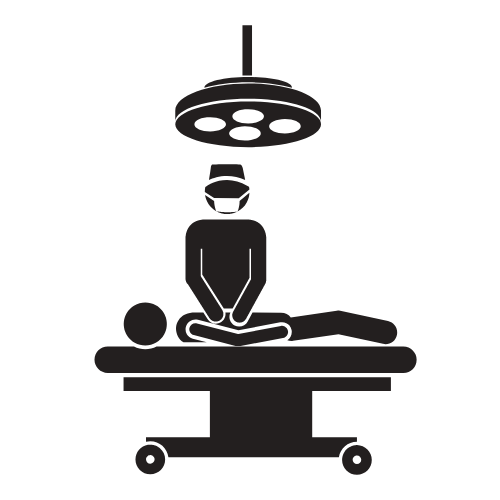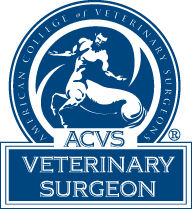THE PROBLEM:
Cranial Cruciate Ligament:
The cranial cruciate ligament is a stabilizing ligament found within the knee or stifle of the dog. This ligament is the equivalent of the anterior cruciate ligament in the dog. Though there are some significant differences between injury of the cruciate ligament between the dog and a person.
The cranial cruciate ligament has three major functions: (1) is to prevent internal rotation of the skin bone, (2) is to prevent hyperextension of the stifle or knee, and (3) is to prevent an instability known as cranial tibial thrust or drawer.
Because the cranial cruciate is located within a joint and thus has poor blood supply, it does not have the capacity to heal like the ligament of say the ankle. Because of this, we do recommend surgical stabilization when a patient has a cruciate ligament injury.
Cranial Cruciate Ligament Injury:
Cruciate ligament injury in dogs tend to be progressive degenerative conditions, unlike humans, who more commonly have acute sporting injuries. Because of this it is not uncommon for dogs to limp intermittently and/or progressively over multiple months. This is because the ligament has thousands of fiber which are degenerating overtime and will continue to tear after initial injury.
THE SURGERY
Surgical Options:
There are two basic concepts on how to address cruciate ligament injury in dogs. The first is to attempt to place a synthetic ligament. In humans, it is common to have a ligament replaced in the same location of the cruciate ligament within the joint itself. This is not a common procedure in dogs and is instead placed outside the joint itself. The limitation of this procedure is that because the material is not in the same location as the cruciate ligament it is placed under large amounts of stress that leads to loosening or stretching. Because of this, these repairs rely on scar tissue to provide long term stability and every dog forms different degrees of scar tissue which lead to variability.
The second concept for stabilization is through alteration of the physics of the knee so that a cruciate ligament is no longer required to stabilize the knee. The procedure we offer is the tibial plateau leveling osteotomy or TPLO to accomplish this.
Tibial Plateau Leveling Osteotomy(TPLO) Procedure:
The TPLO is based on the idea that the top of the shin bone or tibia has a significant slope to it, similar to a hill. The end of the thigh bone or femur resembles a ball sitting on the top of this hill. The cruciate ligament starts at the front of the shin bone and ends at the back of the thigh bone and acts like a tether or a rope preventing the ball from rolling down the slope. When you lose the cruciate ligament, the ball is able to roll down the slope. The TPLO suggests that we would no longer need a cranial cruciate ligament if the ball was on a flat surface instead of a slope. To accomplish this, the bone is cut below all the important structures of the knee. This allows the top to be rotated backwards and the slope to be brought to a level plane. A bone plate with screws is then placed to hold everything in place and allow it to heal. The benefit of this surgery is that bone generally heals to 100% strength and has a very reliable healing pattern, such that ~95% of dogs will resume normal functional activity after healing from this surgery.
RECOVERY
Recovery:
The most challenging portion of this surgery for clients is with the recovery. Recovery is broken into three phases. The first two weeks is the incision healing phase. The first 8 weeks is the bone healing phase and weeks 8-16 are the musculoskeletal rehabilitation phase.
During the incision healing phase pets should be confined in a single room within the home to prevent excessing activity. No running jumping or playing is allowed. Stairs should be limited and only performed in a controlled manner and no leash. Pets must remain on leash at all times when they are outside of their confinement. They will be required to wear an Elizabethan collar or “the terrible cone of shame” at all times during this period. Outside activity is restricted to 5 minute 2-3 times per day for bathroom break only. Your pet will be rechecked at the 2 week mark to ensure the incision has healed. If healing has occurred, then we continue into the bone healing phase.
During the bone healing phase there is no change is in home confinement, meaning a single room with no running, jumping or playing and no access to furniture is allowed. Stairs should be limited and only performed in a controlled manner and no leash. Pets must remain on leash at all times when they are outside of their confinement. For weeks 2-4 pets are allowed 10 minute leash walks 2-3 times per day. For week 4-6 pets are allowed 15minute leash walks 2-3 times per day and for weeks 6-8 pets are allowed 20 minute leash walks 2-3 times per day. Your pet will be rechecked at the 8 week mark and X-rays will be performed to ensure proper healing. Assuming proper healing has been achieved, your pet can transition to the rehabilitation phase.
During the rehabilitation phase, no restrictions are required within the home, however, we have taken a professional athlete, which all pets are, as they perform things people could never do, and made them a couch potato for 8 weeks. Now all there muscles, ligaments and tendons are out of condition and need to be slowly reconditioned to their normal status. This is performed with 2-4 weeks of unlimited on leash activity followed by 2-4 weeks of controlled off leash activity prior to return to normal function.



